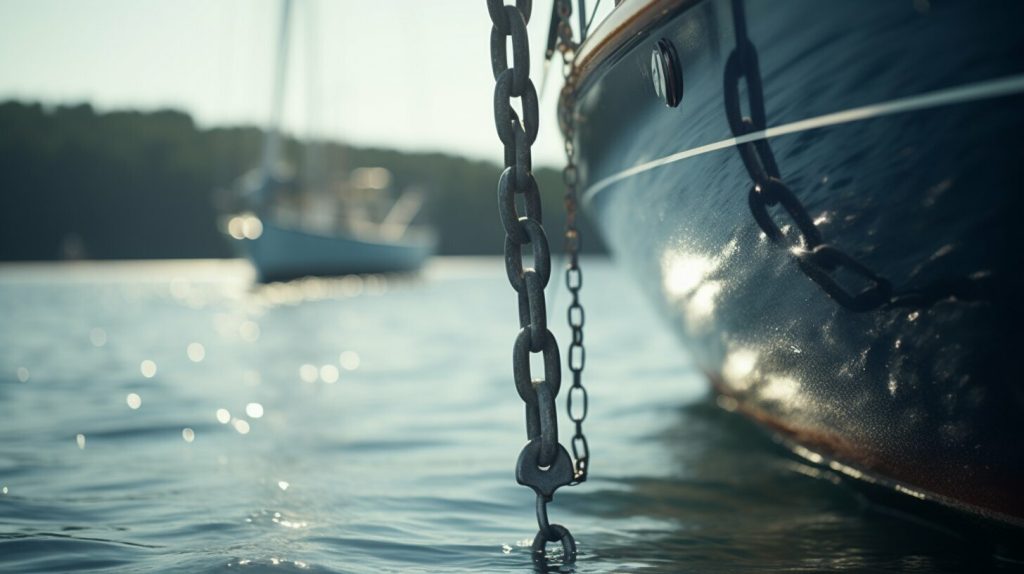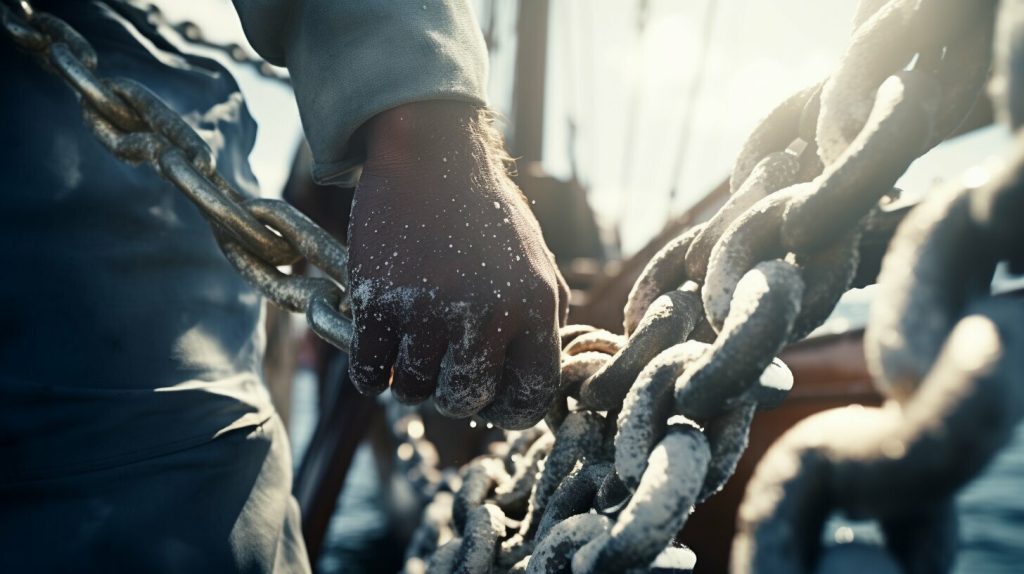Anchoring a sailing yacht is a fundamental skill that every sailor must master. Whether you’re exploring secluded coves or preparing for overnight stays, knowing how to anchor your yacht correctly is crucial for your safety and peace of mind. In this comprehensive guide, I will walk you through the step-by-step process of anchoring a sailing yacht successfully, sharing techniques and best practices that will ensure a secure hold and allow you to enjoy worry-free maritime adventures.
- Choose a suitable anchorage away from strong winds and with a suitable seabed.
- Communicate using hand signals to ensure smooth and silent operation.
- Drop the anchor smoothly, ensuring enough chain is deployed for a secure hold.
- Test the anchor’s hold to ensure stability and make any necessary adjustments.
- Use a snubber or bridle to relieve strain on the windlass and enhance anchoring system.
Choosing the Right Anchorage
Selecting the right anchorage is the first step in ensuring a successful anchoring experience. As a sailor, it is essential to find a quiet spot away from strong winds and potential hazards. A sheltered area with a suitable bottom, such as sand or mud, can provide the necessary holding power for your anchor. Understanding the nature of the seabed is crucial to determine the anchoring technique and the type of anchor to use.
When assessing potential anchorage locations, it is important to consider the depth of the water. An ideal depth will allow your yacht to float freely during tidal changes without dragging the anchor. Taking into account the tidal range, which varies depending on your location, will help you choose an anchorage that provides adequate water depth at all times.
Another factor to consider when choosing the right anchorage is the availability of swinging room. You want to ensure that your yacht has enough space to swing freely without interfering with other vessels or obstacles. This not only prevents potential collisions but also allows your anchor to set and hold securely.
| Key Considerations for Choosing the Right Anchorage |
|---|
| Find a quiet spot away from strong winds and hazards |
| Choose a sheltered area with a suitable bottom (e.g., sand, mud) |
| Consider the depth of the water, taking into account tidal range |
| Ensure there is ample swinging room for your yacht |
By carefully selecting the right anchorage and considering these important factors, you can set the foundation for a successful and worry-free anchoring experience. Remember, the key to seamless anchoring lies in thorough planning, understanding the local conditions, and choosing a location that provides safety and security for your sailing yacht.
Properly assessing the seabed and understanding the depth are essential for a secure anchoring. When anchoring a sailing yacht, it’s crucial to choose an anchorage with a suitable bottom. A seabed consisting of sand or mud provides the best holding ground, ensuring the anchor digs in and holds firm. Avoid rocky or weedy areas as they can prevent the anchor from setting properly.
Before dropping the anchor, gauge the depth of the water. The depth is an important factor in determining how much anchor chain to let out. A general rule of thumb is to use a 5:1 scope, meaning that for every 5 feet of depth, let out 1 foot of chain. This allows the anchor to have enough angle and weight to hold the yacht securely.
Table 1: Anchor Chain Length Guide
| Depth (feet) | Chain Length to Let Out (feet) |
|---|---|
| 10 | 2 |
| 20 | 4 |
| 30 | 6 |
| 40 | 8 |
| 50 | 10 |
Proper assessment of the seabed and consideration of the depth are crucial in anchoring a sailing yacht securely. Choosing a suitable anchorage with a sandy or muddy bottom is essential for a strong hold. Remember to take into account the depth of the water when determining how much anchor chain to let out. By following these guidelines and using the anchor chain length guide in Table 1, you can ensure a proper and secure anchoring experience.
Understanding the seabed and depth is just one aspect of anchoring a sailing yacht successfully. In the next section, we will discuss the significance of weather conditions and swinging room when it comes to anchor placement and system.
Weather Conditions and Swinging Room
Considering weather conditions and allowing for enough swinging room is crucial for safe and secure anchoring. Before dropping the anchor, it’s essential to assess the current weather conditions, including wind speed and direction. Strong winds can cause your yacht to drag or swing unpredictably, posing a risk to both your vessel and neighboring boats. It is advisable to seek sheltered areas with minimal wind exposure.
In addition to wind, it’s also important to consider the tidal range. The rise and fall of tides can significantly impact the depth of water and the swinging room available. Be mindful of the water depth during both high and low tides to ensure your yacht remains within safe limits. Planning ahead and studying tidal charts can help determine the best anchorage locations based on the tidal range in the area.
To accurately assess the swinging room available, take into account the maneuverability of your yacht. Larger vessels require more space compared to smaller boats, and the amount of space needed will also depend on the length of your anchor chain. Ensure there is adequate space between your yacht and nearby vessels, structures, or obstacles, considering any potential changes in wind or tide direction. This will prevent any potential collisions or entanglements, providing you with peace of mind while at anchor.
| Boat Length | Chain Length | Swinging Radius |
|---|---|---|
| 30 feet | 80 feet | 97 feet |
| 40 feet | 100 feet | 124 feet |
| 50 feet | 120 feet | 150 feet |
Remember, the swinging room is dependent on the length of your boat and the amount of anchor chain you deploy. To help you calculate the swinging radius, refer to the example table above. Always ensure you have adequate space for your yacht to swing comfortably without encroaching on nearby vessels or navigational channels.
“Choosing the right anchorage and allowing for enough swinging room will provide a secure and worry-free experience while at anchor.”
By considering weather conditions, tidal range, and providing sufficient swinging room, you can confidently anchor your sailing yacht and enjoy your maritime adventures knowing your vessel is securely held in place.
Dropping the Anchor Smoothly
Dropping the anchor smoothly is a skill that every sailor should master to ensure a successful anchoring experience. It is essential to follow proper techniques and best practices to avoid tangling or dragging. Here are some tips to help you achieve a secure hold:
- Choose the right location: Before dropping the anchor, make sure you have found a suitable spot away from strong winds and with a bottom that provides good holding, such as sand. This will help prevent the anchor from dragging.
- Communicate silently: Communicating with the helmsman is crucial during the anchoring process. Use hand signals instead of shouting to ensure clear and efficient communication.
- Drop the anchor smoothly: When dropping the anchor, do it slowly and smoothly to avoid any sudden jerks or noise. This will minimize the chances of tangling the anchor chain and ensure a secure hold.
- Use the right amount of chain: It’s important to let out enough chain to provide sufficient scope for the anchor to set properly. You can use chain markers to measure how much chain has been let out. A general rule of thumb is to use a scope of at least 5:1, meaning the length of the anchor chain should be five times the depth of the water.
Remember, dropping the anchor smoothly is just one aspect of successful anchoring. It is equally important to test the anchor’s hold, use a snubber or bridle to relieve strain on the windlass, and know when and how to use a secondary anchor for added stability. By following these tips and techniques, you can ensure a worry-free anchoring experience and enjoy your time on the water.
| Tip | Key Point |
|---|---|
| 1 | Choose a suitable location with good holding. |
| 2 | Communicate silently using hand signals. |
| 3 | Drop the anchor smoothly and avoid sudden jerks. |
| 4 | Use enough chain to provide sufficient scope. |
Remember, dropping the anchor smoothly is just one aspect of successful anchoring. It is equally important to test the anchor’s hold, use a snubber or bridle to relieve strain on the windlass, and know when and how to use a secondary anchor for added stability.
Communicating with Hand Signals
Clear communication through hand signals is crucial to ensure a smooth anchoring process. When dropping the anchor, the person responsible for lowering it should use hand signals to convey important information to the helmsman. Here are some standard hand signals commonly used:
- Thumbs up: Indicates that the anchor is securely set and holding well.
- Thumbs down: Indicates that the anchor is not holding and needs to be repositioned.
- Pointing index finger: Indicates the need to let out more chain or adjust the anchor’s position.
- Waving hand side to side: Indicates the need to raise the anchor or that the anchor is fouled.
- Crossed arms across the chest: Indicates that the anchor is stuck and cannot be raised.
By using these signals effectively, the crew can communicate silently and efficiently, avoiding misinterpretations and potential accidents. It’s important to establish these signals before embarking on a sailing trip and ensure that everyone on board is familiar with them.
Testing the Anchor’s Hold
Testing the anchor’s hold is a crucial step in ensuring a worry-free maritime adventure. Once the anchor is firmly set in the seabed, it’s essential to verify its hold before leaving the yacht unattended. This can be done by gently applying reverse power to the anchor chain, checking for any signs of dragging or slipping. If the anchor holds steady, it’s a good indication that it has dug into the seabed and is secure.
During this testing process, it’s important to pay close attention to any changes in the anchor’s position or the tautness of the chain. If there is any doubt about the anchor’s hold, it’s advisable to reset the anchor or seek an alternative anchorage. Remember, the safety of both the yacht and its occupants relies on a dependable anchor hold.
“Testing the anchor’s hold is a crucial step in ensuring a worry-free maritime adventure.”
Table 1: Anchor Hold Testing Guide
| Step | Description |
|---|---|
| 1 | Apply gentle reverse power to the anchor chain. |
| 2 | Observe for any signs of dragging or slipping. |
| 3 | Monitor changes in the anchor’s position and chain tautness. |
| 4 | If unsure about the anchor’s hold, consider resetting or finding an alternative anchorage. |
By following this anchor hold testing guide, you can have peace of mind knowing that your yacht is securely anchored. Remember, proper testing is instrumental in preventing unexpected anchor dragging and ensuring a safe and enjoyable sailing experience.
Using a snubber or bridle is a smart practice to protect your windlass and enhance the performance of your anchor system. When you drop the anchor, it’s important to reduce strain on the windlass and prevent damage. A snubber or bridle acts as a shock absorber, absorbing the tension and providing a secure hold.
One popular option is a snubber, which is a line attached to the anchor chain. It’s recommended to use a snubber with a length equal to at least three times the depth of the water. Attach the snubber to a strong point on the bow, such as a cleat or a strong point on the anchor roller. This will help distribute the load evenly and reduce stress on the windlass.
Alternatively, a bridle can be used, which involves attaching the snubber line to both sides of the bow. This spreads the load even further, providing additional stability. It’s important to ensure the snubber or bridle is properly secured and adjusted before setting the anchor. Regularly inspect the lines for wear and replace them if necessary to maintain their effectiveness.
| Key Points: | Benefits: |
|---|---|
| Use a snubber or bridle to reduce strain on the windlass and prevent damage. | Protects the windlass and enhances anchor system performance. |
| Attach the snubber to a strong point on the bow. | Distributes load evenly and reduces stress on the windlass. |
| Consider using a bridle for additional stability. | Spreads the load further, providing increased security. |
“Using a snubber or bridle is an essential practice for any sailor looking to protect their windlass and optimize their anchoring system. By reducing strain and providing shock absorption, these tools ensure a secure hold and peace of mind during your maritime adventures.” – Captain John Smith
By incorporating a snubber or bridle into your anchoring routine, you can prolong the life of your windlass and improve the overall performance of your anchor system. Remember, proper installation and regular maintenance are crucial to ensure their effectiveness. So, the next time you drop anchor, make sure to protect your equipment and enhance your anchoring experience with a snubber or bridle.
Understanding when to employ a secondary anchor can greatly enhance the stability and safety of your yacht while at anchor. There are certain conditions where using a secondary anchor is necessary, such as when strong winds or currents are expected.
When selecting a secondary anchor, it is important to choose one that complements your primary anchor. The secondary anchor should have a similar holding power and be appropriate for the seabed conditions. By using two anchors, you can distribute the load and reduce the chances of dragging.
When setting up a secondary anchor, it is recommended to position it at an angle of 45 degrees from the primary anchor. This will help minimize the chances of the two anchors becoming tangled. Additionally, make sure to use a separate rode for the secondary anchor and attach it to a different point of the boat to maximize stability.
Secondary Anchoring Best Practices
- Choose a suitable secondary anchor with similar holding power to the primary anchor.
- Position the secondary anchor at a 45-degree angle from the primary anchor to prevent entanglement.
- Use a separate rode for the secondary anchor and attach it to a different point of the boat for added stability.
- Regularly check the tension and position of the secondary anchor to ensure it is holding securely.
“Using a secondary anchor can provide additional peace of mind and ensure that your yacht remains secure even in challenging conditions.”
By understanding the importance of secondary anchoring and following best practices, you can enhance the stability and safety of your yacht while at anchor. Remember to choose a suitable secondary anchor, position it correctly, and regularly check its tension and position. With these measures in place, you can enjoy worry-free anchoring and fully embrace your maritime adventures.
| Key Points | Benefits |
|---|---|
| Using a secondary anchor | Enhanced stability and safety |
| Positioning at a 45-degree angle | Prevents entanglement |
| Separate rode and attachment point | Maximizes stability |
| Regular checks | Ensures secure hold |
Lifting the Anchor with Care
Lifting the anchor with care is essential to prevent any damage to your yacht’s vital equipment. After enjoying a peaceful anchorage and preparing to set sail once again, follow these steps to safely retrieve your anchor.
1. Slowly increase the tension on the anchor rode by using the windlass. Avoid jerking or yanking the anchor up abruptly, as this can strain the windlass and potentially cause damage. Gradually apply steady pressure until the anchor breaks free from the seabed.
2. As the anchor comes closer to the surface, be cautious of any debris or obstacles that may be attached to it. Clear away any seaweed, ropes, or other materials to ensure a smooth retrieval.
3. Once the anchor is fully retrieved, rinse it with freshwater to remove any residual salt or sand. This will help prolong the lifespan of your anchor and prevent corrosion.
| Tip | Key Point |
|---|---|
| 1. | When lifting the anchor, position yourself away from the sea and maintain a firm grip on the windlass handle. |
| 2. | Ensure the anchor is securely stowed before setting sail. Double-check that all connections are tight and properly aligned. |
| 3. | Regularly inspect your anchor, chain, and windlass for signs of wear or damage. Proper maintenance and timely repairs are essential for safe and efficient anchoring. |
“Lifting the anchor smoothly and with great care not only ensures the longevity of your yacht’s equipment but also allows for a stress-free departure from your anchorage. Take the time to perform this task conscientiously, and you’ll be rewarded with peace of mind during your boating adventures.” – Captain John Doe
Planning and Preparation
Successful anchoring starts with careful planning and thorough preparation. Before setting out on your maritime adventure, take the time to gather important information about the area you plan to anchor in. Consider factors such as weather conditions, tidal range, and depth to ensure a safe and secure anchorage.
First and foremost, it’s crucial to choose a suitable location that provides shelter from strong winds and rough waves. Look for calm bays or coves that offer protection and minimize the risk of your yacht drifting or dragging. Additionally, pay attention to the seabed composition. An anchor will have a better hold on sandy or muddy bottoms as opposed to rocky or weedy surfaces.
Communicating effectively with your crew is also essential during the anchoring process. Instead of shouting or using radios, opt for silent communication through hand signals. Establish a clear set of signals beforehand and ensure everyone on board understands their meaning. This will help maintain a calm and efficient atmosphere while dropping and securing the anchor.
| Key Points: |
|---|
| Choose a suitable location with shelter from strong winds |
| Consider the composition of the seabed |
| Use hand signals for silent communication |
Once you’ve arrived at your chosen anchorage, it’s time to drop the anchor smoothly. Slowly approach the desired spot, taking note of any hazards or obstacles along the way. Once you’re in position, reduce your speed and gently release the anchor, allowing the chain to run out as the yacht drifts back. Avoid sudden jerks or excessive speed, as this could cause the anchor to tangle or drag.
After dropping the anchor, it’s important to test its hold. Reverse the engine gently to ensure the anchor has securely dug into the seabed. Monitor the boat’s position and observe if it holds steady or starts to drift. If the anchor doesn’t hold, consider repositioning or adjusting the amount of chain you’ve let out.
Before lifting the anchor, make sure to take some time to appreciate your surroundings and double-check all necessary preparations. Secure loose items on deck, ensure proper stowage of anchor gear, and gather any required tools or equipment. By following these steps and taking the time to plan and prepare, you’ll be well on your way to mastering the skill of anchoring a sailing yacht seamlessly.
Conclusion
Anchoring a sailing yacht is a skill that can be mastered with practice, knowledge, and attention to detail. By following the techniques and best practices outlined in this comprehensive guide, you can confidently anchor your yacht, ensuring a secure hold and enjoying worry-free maritime adventures.
When it comes to anchoring, there are several important principles to keep in mind. First and foremost, finding the right anchorage is crucial. Look for a quiet spot away from strong winds and with a suitable bottom, such as sand, to provide optimal holding.
Communication during the anchoring process should be done silently, using hand signals to convey messages between the person dropping the anchor and the helmsman. This ensures efficient and effective communication without the need for words.
When dropping the anchor, it’s important to do so smoothly and with plenty of chain. This allows for a secure hold and reduces the risk of the anchor tangling or dragging. Chain markers can be used to measure how much chain has been let out, providing a clear indication of the depth.
Testing the anchor’s hold is a critical step to ensure a secure anchorage. Checking the anchor’s grip and making any necessary adjustments is essential for maximum stability and security. Additionally, using a snubber or bridle can help alleviate strain on the windlass, further enhancing the effectiveness of the anchoring system.
Knowing when and how to use a secondary anchor is another important aspect of successful anchoring. In certain conditions, deploying a secondary anchor can provide added stability and reduce drag and swing. Understanding these techniques will greatly enhance your anchoring experience.
Finally, lifting the anchor should be done carefully to prevent damage to the windlass. With proper planning, understanding weather conditions, and selecting the right location, you can ensure a smooth and efficient lifting process.
Remember, anchoring a sailing yacht is a skill that requires practice and attention to detail. By mastering these techniques, you can confidently anchor your yacht and embark on worry-free maritime adventures, knowing that your vessel is securely held in place.
FAQ
Q: What is the most important principle to keep in mind when anchoring a sailing yacht?
A: It’s crucial to find a quiet spot away from strong winds and with a suitable bottom, such as sand.
Q: How should communication be done when dropping the anchor?
A: Communication should be done quietly using hand signals.
Q: How should the anchor be dropped?
A: The anchor should be dropped smoothly and with plenty of chain.
Q: Why is testing the anchor’s hold important?
A: Testing the anchor’s hold is crucial to ensure a secure anchorage.
Q: How can a snubber or bridle help with anchoring?
A: Using a snubber or bridle can help take the strain off the windlass and enhance the anchoring system.
Q: When should a secondary anchor be used?
A: A secondary anchor should be used in certain conditions to ensure maximum stability and security.
Q: How should the anchor be lifted to prevent damage to the windlass?
A: Lifting the anchor should be done carefully to prevent damage to the windlass.
Q: What factors should be considered during planning and preparation for anchoring?
A: Factors such as weather conditions, tidal range, and depth should be considered during planning and preparation for anchoring.












